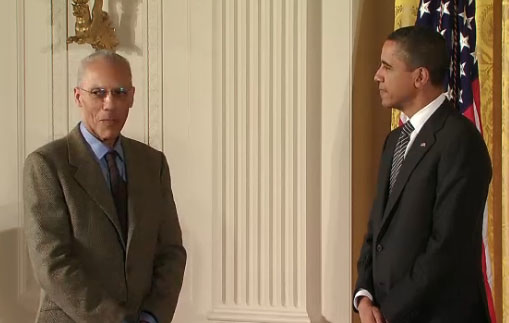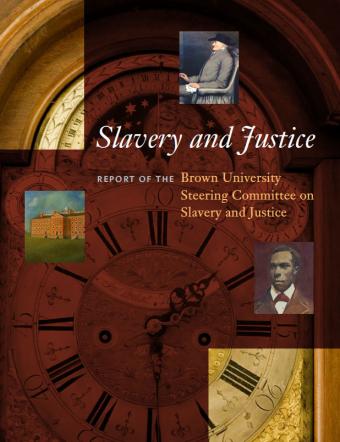PROVIDENCE, R.I. [Brown University] — At its February meeting, the Corporation of Brown University selected acclaimed American artist Martin Puryear to create a slavery memorial on the University campus. Recommended by the Steering Committee on Slavery and Justice, which issued its report in 2006, the memorial will recognize the University’s relationship to the transatlantic slave trade and the importance of this traffic in the history of Rhode Island. The memorial is conceived as a site for discussion, education, and contemplation.
The memorial will be placed on the Front Campus, between Hope College and Carrie Tower, and near University Hall. This site was recommended by Brown’s Public Art Committee for its prominence, especially during Convocation and Commencement, and its historic significance as the site of the University’s earliest building. Construction ledgers from the 18th century name four enslaved Africans among those who worked on the construction of University Hall.
“The selection of Martin Puryear and the choice of the Front Green — the ‘Quiet Green’ — as the site for his work is a promising and satisfying step forward,” said Brown University President Ruth J. Simmons. “This memorial will invite thoughtful inquiry about the world we have inherited and contemplation of the values we embrace and intend to pass on.”
Members of the Public Art Committee unanimously chose Puryear from a slate of more than 65 artists, architects, and landscape architects and from five finalists, who visited campus to discuss their potential approaches to the project. Puryear’s thoughtful discussion and commitment to the significance of the memorial impressed the committee.

Puryear is widely recognized for finely crafted abstract sculpture. He has said, “I value the referential quality of art, the fact that a work can allude to things or states of being without ... representing them. ... The most interesting art for me retains a flickering quality, where opposed ideas can be held in tense coexistence.” Puryear’s evocative explorations in abstract forms retain vestigial elements of utility from everyday objects found in the world, according to Jo-Ann Conklin, director of the University’s David Winton Bell Art Gallery. This approach is demonstrated in Puryear’s well-known Ladder for Booker T. Washington. The spindly, meandering, 35-foot tall ladder narrows toward the top, creating a distorted sense of perspective that evokes an unattainable or illusory goal.
Puryear is currently working on a design for the memorial, which will be presented to the Public Art Committee this summer. The memorial is expected to be installed in time for Brown’s 250th anniversary celebration in 2014.
Martin Puryear
Martin Puryear was born in Washington, D.C., in 1941. After earning his B.A. from Catholic University in Washington, D.C., he joined the Peace Corps in Sierra Leone and later attended the Swedish Royal Academy of Art. He received an M.F.A. in sculpture from Yale University in 1971. Puryear’s work has been shown in important international institutions since the late 1970s, and a major traveling retrospective of his work was organized by the Museum of Modern Art in New York in 2007. He represented the United States at the Bienal de São Paulo in 1989, where his exhibition won the grand prize.
He is the recipient of numerous awards, including the prestigious John D. and Catherine T. MacArthur Foundation Award, a Louis Comfort Tiffany Grant, and the Skowhegan Medal for Sculpture. Puryear was elected to the American Academy and Institute of Arts and Letters in 1992 and received an honorary doctorate from Yale University in 1994. He lives and works in the Hudson Valley region of New York.
Public Art Committee members
- Artemis Joukowsky, chancellor emeritus, chair
- Craig Barton, 1977 alumnus and vice chair of the Corporation Committee on Facilities and Design
- Karen Allen Baxter, managing director, Rites & Reason Theatre
- Jo-Ann Conklin, director, David Winton Bell Art Gallery
- Spencer Crew, the Robinson Professor of American, African American, and Public History at George Mason University and former director of the National Underground Railroad Freedom Center
- Robert Emlen, University curator and senior lecturer in American Studies
- Richard Fishman, director, Creative Arts Council and professor of visual arts
- Steven Lubar, director, John Nicholas Brown Center for Public Humanities and Cultural Heritage and director of the Haffenreffer Museum of Anthropology
- Steve Maiorisi, vice president, facilities management
- Dietrich Neumann, professor of the history of art and architecture
- Obasi Osborne, an undergraduate student.
The Public Art Committee will give a public presentation about the memorial at the Brown Community Meeting on Tuesday, Feb. 28, 2012.
Slavery and Justice
Brown University President Ruth J. Simmons appointed the Steering Committee on Slavery and Justice in 2003 and charged that panel of faculty members, students, and administrators with investigating and preparing a report about the University’s historical relationship to slavery. The final report, presented in October 2006, concluded that some of the University’s early benefactors were involved in the slave trade and that the University benefited from that involvement. In February 2007, the Brown Corporation endorsed a set of initiatives in response to the Committee’s report. Among the recommendations was that the University memorialize the history revealed in the committee’s report by creating a “living site of memory, inviting reflection and fresh discovery without provoking paralysis or shame.”
A 10-member Commission on Memorials, composed of members of the Brown community as well as individuals nominated by the governor of Rhode Island and mayor of Providence, was established in 2007 and charged with developing ideas for how best to acknowledge the University and community’s historical relationship to slavery and the transatlantic slave trade. Among their recommendations made in 2009 was that the Public Art Committee of the University be asked to commission a memorial.
Other actions taken by Brown in response to the report include initiatives to improve public education in the Providence area. The University announced a $10-million target for an endowment for Providence public schools, the Fund for the Education of the Children of Providence, and launched the Urban Education Fellows program, which forgives tuition for Brown graduate students who agree to serve Providence-area schools for at least three years after they earn a Master of Arts in Brown’s Urban Education Policy Program or a Master of Arts in Teaching.
Additionally, the University is committed to exploring how best to carry out a major research and teaching initiative on issues of slavery and justice; to recruiting a director of a Center for Slavery and Justice; and to continuing other projects approved by the Corporation in response to the steering committee’s report.

